If you’re in the market for a new sports smartwatch, the Garmin Fenix 7 and Garmin Instinct 2 are likely to be on your shortlist.
Garmin released the two smartwatches at the beginning of 2022, with the Garmin Fenix 7 replacing the outgoing Fenix 6 as the brand’s flagship solar-enhanced sports smartwatch. The Fenix 7 has a number of new features, including a touchscreen and new training programmes, such as HIIT workouts.
The Instinct 2 received a number of updates over its predecessor and remains, in Garmin’s words, a smartwatch for “rugged individualists”. This is the first generation of the Instinct to be offered in two sizes and it has an improved battery life compared to the previous version.
The watches provide plenty of features to help record your bike rides, take your training up a notch and discover new routes, with mapping on both. They can also provide 'wellness' insights and share some of the everyday functionality we’ve come to expect from other wearable tech, such as contactless payments.
However, these two watches are built with different users in mind and come in at very different price points, with the Instinct 2 starting at £299.99 / $349 and the Fenix 7 starting at £599 / $699.99 but rising to more than £1,000 / $1,000.
We’ve received both the new Fenix 7 and Instinct 2 to review, so before testing gets underway, we’ve put the two watches side by side to highlight the most important features for cyclists.
Garmin Fenix 7 and Instinct 2 range information
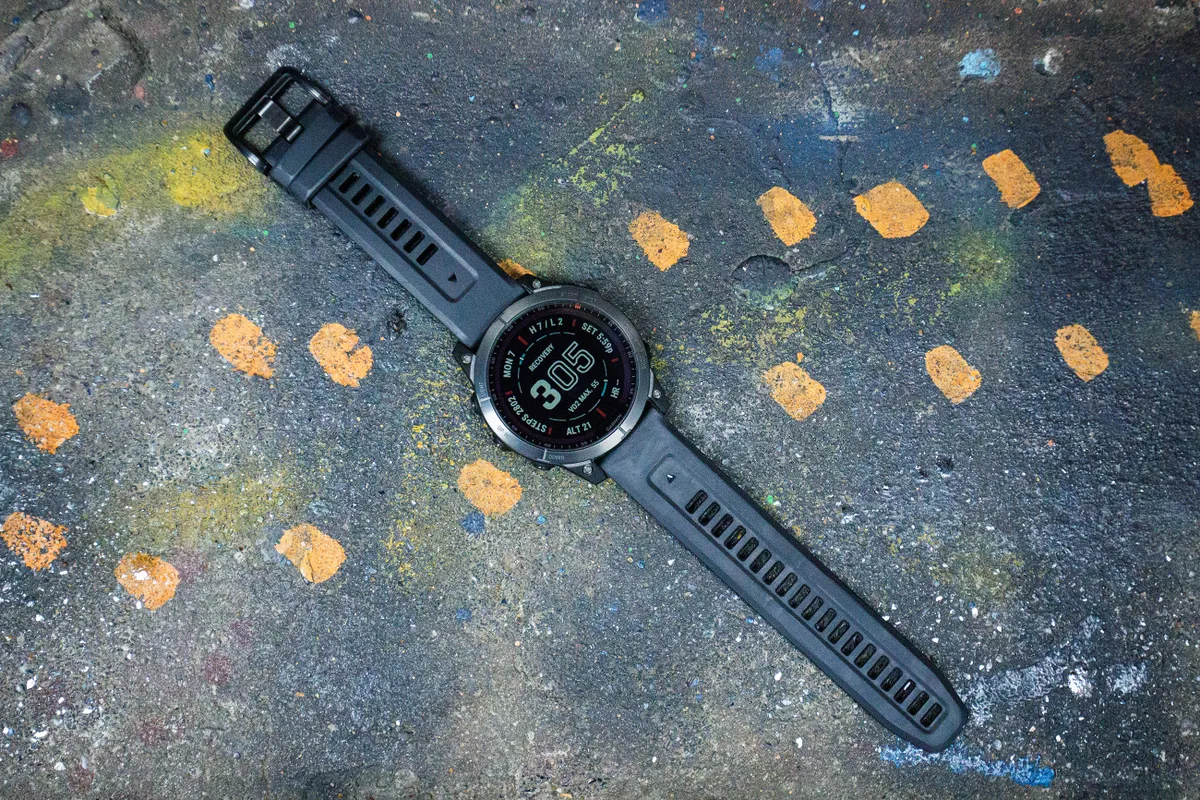
Both watches are offered in a variety of different models and styles, creating a dizzying array of options.
The Fenix 7 comes in three sizes: small, standard and large. It has either a standard lens, a solar-enhanced lens that charges the watch via sunlight, a reinforced sapphire lens, or combination solar and sapphire lens on some models. It also comes with a variety of different bezel designs and watch strap options.

The Instinct 2 is available in two sizes: small and standard. Like the Fenix 7, it comes with either a standard or solar-enhanced screen. There are a number of different designs, including a Surf Edition with dedicated water sports modes and a Tactical Edition with enhanced functionality for military personnel.
For our comparison, we’ve chosen the Garmin Fenix 7 Sapphire Solar and the Garmin Instinct 2 Solar.
Display

Both watches have memory-in-pixel displays and will charge via the sun. However, apart from these two features, the displays on the Fenix 7 Sapphire Solar and Instinct 2 Solar have little else in common.
The Fenix 7 has a 260x260 pixel display, whereas the Instinct 2 has a lower-resolution, 176x176 pixel display.
The Fenix 7, in the standard size we have, also has a larger 1.3in display compared to the 0.9in display on the standard Instinct.
These factors come together to mean the Fenix 7 can display more data fields in more detail than the Instinct 2, which means it should be easier to read at a glance.
The other major difference is the fact the Fenix 7 has a colour display and the Instinct 2 is monochrome. Once again, this makes the Fenix 7 easier to read than the Instinct 2, particularly when it comes to mapping. However, it does contribute to the Fenix 7 having a shorter battery life – but more on that later.
Finally, one of the major updates to the Fenix 7 compared to the outgoing Fenix 6 (you can read our Garmin Fenix 6 review) is the introduction of a touchscreen, to complement the buttons on the watch’s bezel.
Based on my first impressions, this makes the Fenix more intuitive to use and the menus easier to navigate. The Instinct 2 does not have a touchscreen, and instead, you must use the buttons on the bezel.
Design

The Fenix 7 comes in three different case sizes with the smallest being 42x14.1mm and the largest being 51x14.9mm. The standard edition we have has a 47x14.5mm case.
All the Fenix 7 watches come with a stainless steel or titanium bezel. The titanium bezel is available in a Raw Titanium colour, Mineral Blue or Carbon Grey, as on the watch we have.
There are also a number of strap options, including different colour silicone straps, and leather or metal versions. These are interchangeable and some Fenix 7 watches come with multiple options, so you can tailor the look of the watch.

The Instinct 2 comes with either a 40x13.1mm case or a 45x14.5mm case, making it smaller than the Fenix 7. However, Garmin says the smallest Instinct 2 is suitable for wrists down to 112mm in circumference, whereas the smallest Fenix 7 is suitable for wrists down to 108mm in circumference, with the silicone strap.
The Instinct 2 also has a fibre-reinforced polymer case and is only available with a silicone strap.
The Instinct 2 is available in a number of different colours and contrasting designs. The Tactical version is available in a camouflage pattern.
Garmin says the Instinct 2 will also be available via its ‘Your watch. Your way’ programme, where you can customise the watch with more than 240 possible design options.
Features
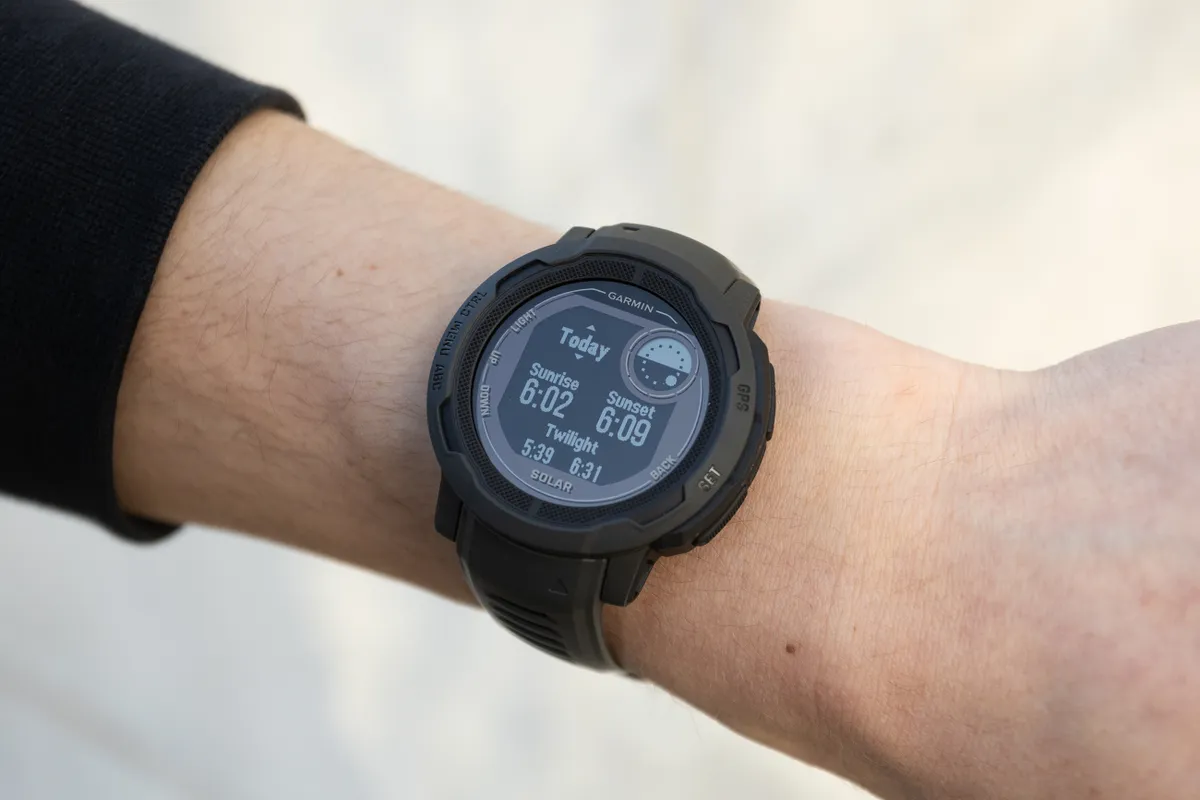
When it comes to whether you should choose a bike computer, smartphone, or smartwatch to record your rides, the best bike computers have a number of advantages. After all, they're designed specifically for the job.
However, if you want better insight into other aspects of your health or the convenience of a wearable smart device that can be used across a variety of sports, a smartwatch can be a good choice.
The Fenix 7 and Instinct 2 are no exception and have many features tailored to a range of activities, including different types of cycling.
Cycling activity modes

The Fenix 7 and Instinct 2 come loaded with a number of different activity profiles for different types of cycling, including road cycling, mountain biking and indoor cycling. They also have profiles for electric bikes, commuting and more.
The different activity profiles have screens and data fields tailored to the riding discipline. For instance, the road cycling profile displays heart rate on the main activity screen, whereas the mountain biking profile has altitude instead of heart rate.

These screens and data fields are customisable so you can switch them around to show your choice of metrics or add your preferred functions, such as mapping, a compass, power when the watch is paired with a power meter, or music controls.
Mapping and navigation
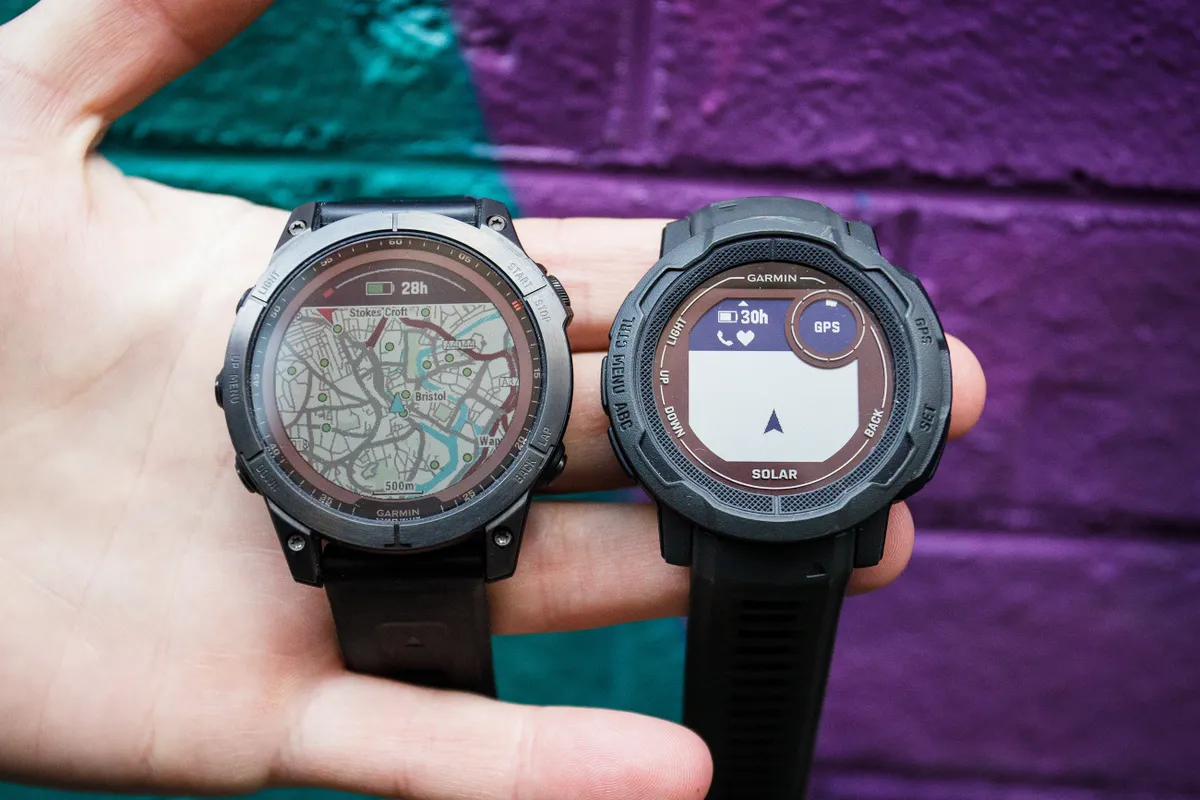
The Instinct 2 and Fenix 7 differ dramatically when it comes to mapping.
The Instinct 2 doesn’t have any maps, but the Fenix 7 has downloadable maps with terrain, landmarks, roads, trails and points of interest. There are also ski routes and golf courses. You can customise the appearance of the Fenix 7’s mapping with options such as popularity (a heatmap of popular segments), dark mode and high contrast.
The Instinct 2 can be loaded with a route and it will provide a breadcrumb trail, like early Garmin bike computers. Fenix 7 will also provide a breadcrumb trail but it will also show a real-world map below the route, too, and will tell you when to turn. If you go off-course, the Fenix 7 will also warn you. The mapping on the Fenix 7 also benefits from the watch’s colour screen, making details easier to discern.
Both watches can route you back to the beginning of a course, but due to the Fenix 7’s detailed maps it can provide the best route.
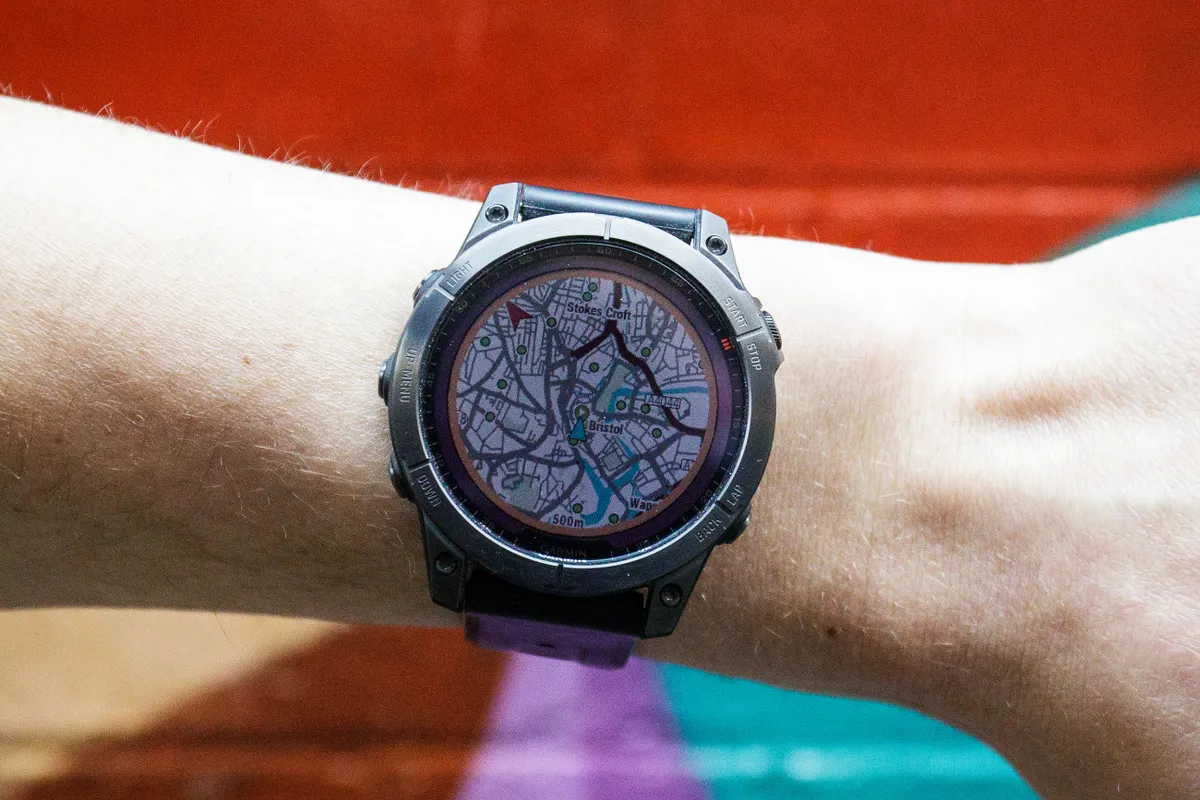
The Fenix 7 also has ClimbPro, which isn’t available on the Instinct 2. This feature splits up the route into climbs providing insight into gradient and the distance left to go on a given climb, which can help with pacing and measuring effort.
The Instinct 2 will provide an elevation profile of your route, so you can gain some insight into what’s ahead.
The touchscreen on the Fenix 7 makes using the map function slightly easier than on the Instinct 2’s button-operated display.
However, throw winter gloves or water into the mix and the Fenix 7’s touchscreen feature might become redundant fairly quickly and you’ll resort to using the buttons on the watch’s bezel. Regardless of this, some riders prefer the simplicity of physical buttons to navigate around a smart device.
Despite differences in appearance, the mapping on the two watches is powered by Multi-GNSS. This is a combination of different global navigating systems (GPS, GLONASS and Galileo) which Garmin says should provide tracking in “more challenging environments than GPS alone.”
Heart-rate monitor

Both watches come equipped with a wrist-based heart-rate monitor, in the form of an optical sensor on the back of the watches.
While wrist-based heart-rate monitors are generally considered to be less accurate than chest-strap heart-rate monitors, this feature enables the watches to provide insight into activity intensity, blood oxygen levels and wellness, as well as providing ‘always-on’ heart-rate data without a chest strap.
Both watches support ANT+ and Bluetooth Smart broadcasting, so you can broadcast your heart rate to a third-party app or other devices from the optical sensor.
Training features

The Fenix 7 and Instinct 2 have a number of dedicated training features, in the form of insights into performance and recovery, as well as dedicated workouts.
Both watches support interval training and HIIT workouts, as well as enabling you to download training plans.

The Fenix 7 has a number of training features that the Instinct 2 does not. These features include 'Real-Time Stamina', which allows users to monitor exertion levels during activities and 'Up Ahead', which alerts you to landmarks and points of interest on your route.
If you're using the Fenix 7 for running, its 'Visual Race Predictor' will estimate how long it will take you to run race distances such as 5km, based on your running history and overall fitness.
Both watches will provide training status (such as ‘maintaining’ or ‘recovery’), training load and VO2 Max estimates, and will suggest daily workouts. They will also provide suggested recovery times after workouts.
Health metrics

One of the main advantages of using a smartwatch over a bike computer is the former can offer insight into general “wellness” using heart-rate data.
The watches will monitor exertion levels and training load to provide estimated energy reserves in the form of Garmin’s 'Body Battery' score. Both watches will also analyse sleep to provide sleep-quality scores, monitor perceived stress levels and alert wearers to abnormally high or low heart rates.
They can also provide insight into hydration levels and enable you to monitor menstrual cycles, but these features are accessible in the Garmin Connect app rather than on the watches themselves.
The Fenix 7 and Instinct 2 both have Garmin’s 'Pulse Ox' feature that shows blood oxygen levels so you can see how your body is responding to acclimation.
Other useful features

The Fenix 7 and Instinct 2 have a number of everyday features that are similar to those offered by smartwatches such as the Apple Watch.
For instance, the watches support contactless payments with select banks in different territories.
The watches will also act as an auxiliary device to your smartphone, enabling you to answer calls and receive push notifications.
Music can be stored on both devices and listened to with Bluetooth headphones. You can also download music apps such as Spotify.
Battery life

The versions of the Garmin Fenix 7 and Instinct 2 we have in this article both have 'solar harvesting capacity'. This means the watch will be charged when exposed to the sun via the screen. Consequently, you can possibly go longer between charges with these watches than their non-solar equivalents.
For the Fenix 7 Sapphire Solar we have here, Garmin claims up to 22 days' battery life with solar in GPS mode or 173 days in battery saver mode. These figures are on the condition of three hours of exposure to sunlight per day in 50,000 lux conditions, although Garmin doesn’t expand on what kind of conditions this translates to in the real world.
How usable solar charging is will ultimately depend on where you’re using the watch and how likely there is to be at least some sunshine.
For the larger Fenix 7X, Garmin says it has increased the solar-harvesting capacity by over 200 per cent in smartwatch when compared to the Fenix 6. This means the watch has a maximum battery life of a claimed five weeks. However, the same exposure to sunlight stipulations apply.
The Instinct 2 Solar has a claimed battery life of up to 370 hours (roughly 15 days) in GPS mode. With three hours of sunlight per day in 50,000 lux conditions, Garmin says the Instinct 2 Solar’s run time is unlimited in battery saver mode and 54 days in smartwatch mode.
Pricing & Availability
The Fenix 7 and Instinct 2 come in at notably different price points, with the most affordable Instinct 2 costing £299.99 / $349.99 and the Fenix 7’s pricing starting at £599.99 / €699.99, but extending to more than £1,000 / $1,000 with personalised straps and body designs.
The Fenix 7 Sapphire Solar photographed in this article costs £779.99 / €899.99, while the Instinct 2 Solar costs £389.99 / $449.99 / €449.99.
Garmin Fenix 7 pricing and deals
Garmin Fenix 7S pricing
- Standard: £599.99 / $699.99 / €699.99
- Solar: £689.99 / $799.99 / €799.99
- Sapphire Solar: £779.99 / $899.99 / €899.99
Garmin Fenix 7S deals
Garmin Fenix 7 pricing
- Standard: £599.99 / $699.99 / €699.99
- Solar: £689.99 / $799.99 / €799.99
- Sapphire Solar: £779.99 / $899.99 / €899.99
Garmin Fenix 7 deals
Garmin Fenix 7X pricing
- Solar: £779.99 / $899.99 / €899.99
- Sapphire Solar: £859.99 / $899.99 /€999.99
Garmin Fenix 7X deals
Garmin Instinct 2S and Instinct 2 pricing
The pricing of the Instinct 2S (40mm screen) and Instinct 2 (45mm screen) is the same.
- Standard: £299.99 / $349.99 / €349.99
- Solar: £389.99 / $449.99 / €449.99
Garmin Instinct 2S and Instinct 2 deals
Conclusion
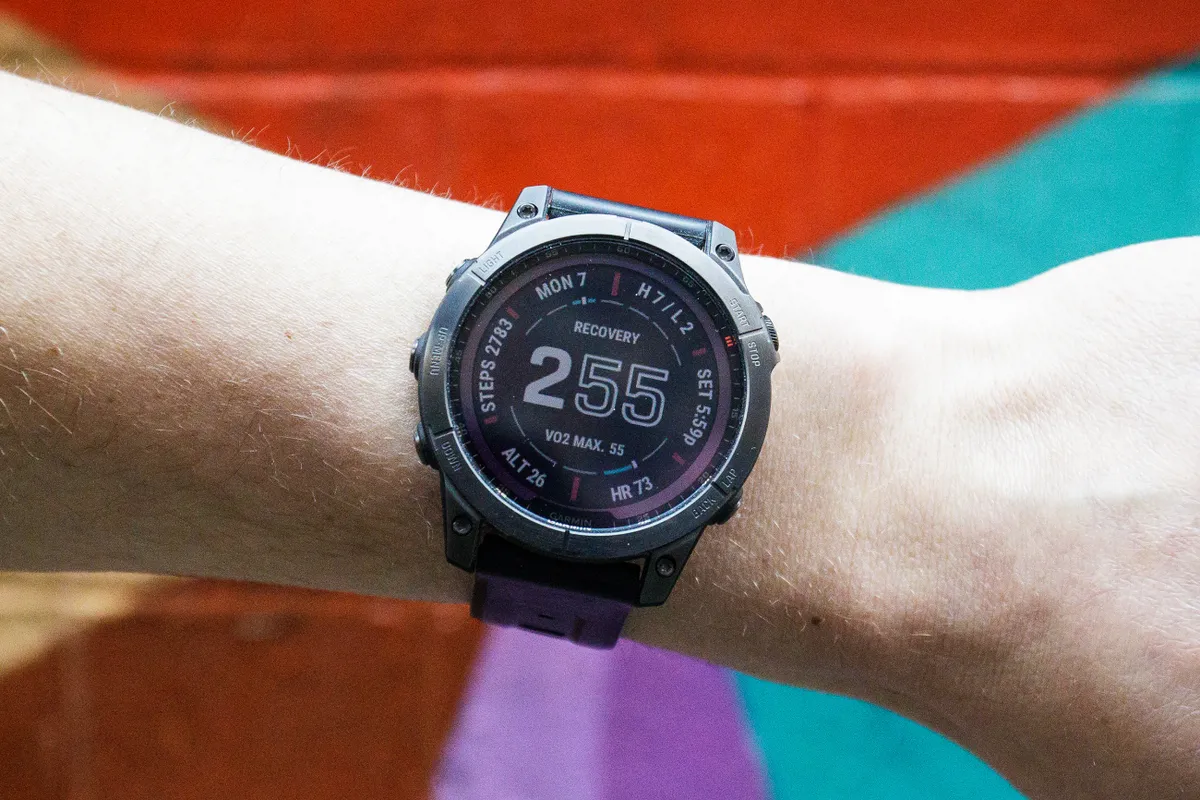
The Fenix 7 Sapphire Solar is the higher-end option of these two smartwatches, sitting at the top of Garmin’s multisport smartwatch range.
It's packed with training features and mapping, all made easier to view and control thanks to the watch’s colour display and new touchscreen. The sapphire screen should go some way to protecting the watch face and, thanks to the solar harvesting, the battery life is seriously impressive, too (in the right conditions).
The Fenix 7 Sapphire Solar also has much of the same functionality as other wearable tech such as the Apple Watch, supporting contactless payments, third-party apps such as Spotify, and displaying push notifications from your mobile phone. Combine these features with its smart looks and this watch will provide plenty of day-to-day use without screaming “sport”.
However, the depth of functionality and the appearance do come at a high price, with the Fenix 7 costing significantly more than the Instinct 2.

While the Instinct 2 Solar doesn’t quite have the looks of the Fenix 7, with a plastic rather than a metal case, or the functionality of the touchscreen, it does have many of the same training functions and everyday features as its much pricier sibling.
The Instinct 2 will enable you to navigate via a breadcrumb trail, but its lack of maps might be a drawback on some adventures. On the other hand, its rugged design is arguably better suited to life in the great outdoors.
The battery life of the Instinct 2 Solar is also impressive, in part thanks to the monochrome display, and Garmin’s claim for unlimited battery life in the right light conditions makes it a desirable choice if you’re looking for a watch to wear every day and take on adventures.
If you want a top-shelf training tool that will support you across many different activities and looks more like a classic watch, then the Fenix 7 could be what you need. If you’re looking to save money and appreciate rugged, pared-back functionality, the Instinct 2 should tick all the boxes.

